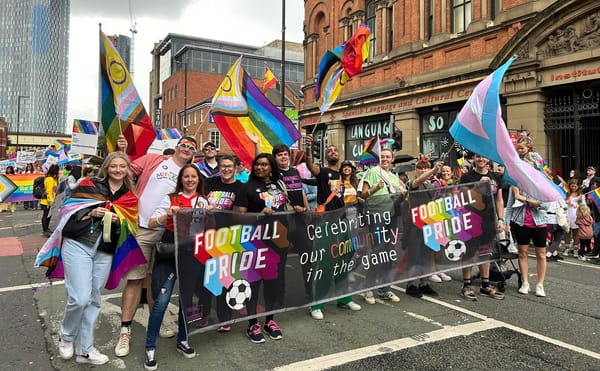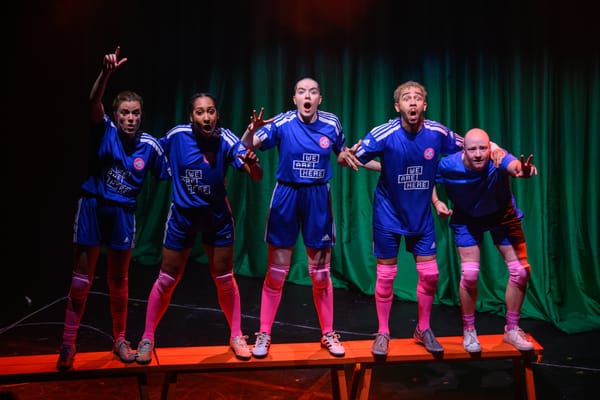What men’s football could learn about LGBTQ+ inclusion from women's football
Three events, three reasons why women's football gets LGBTQ+ inclusion right and men's football gets it wrong.
When I’ve discussed this newsletter with family and friends, several of them have asked me why LGBTQ+ inclusion so different in women’s football compared to men’s football. Today, Polly Starkie begins to dig into those differences and offers a couple of suggestions as to why it might be.
Enjoy, and don’t forget to subscribe to Out and Out Football for free to get writing about LGBTQ+ identity and football in your inbox every week.
Adam
By Polly Starkie
When the 2019 World Cup came around, I was hooked. I’d discovered women’s football in 2017 and had gone along to the 2017 Women’s FA Cup Final at Wembley. 2019 was a great time to be an England fan with the Lionesses finishing fourth –only the second time they had reached a World Cup semi-final .
It was Scandinavia, however, that grasped my attention. Sweden had beaten Canada in the last 16. Swedish defender Magdalena Eriksson headed to the stands to celebrate with friends and family.
When she arrived in the stands, Eriksson’s girlfriend, Pernille Harder, another footballer and the captain of the Danish national women’s football team, greeted her with a kiss. The kiss was captured by a photographer.
The photo went viral. It spread beyond women’s football circles, and it made headlines.
As a teenager struggling with understanding my sexuality, seeing representation of a gay couple on such a huge stage was so relieving.
Harder and Eriksson were and still are two hugely respected players and seeing them so nonchalantly expressing their love for each other without considering the impact is so refreshing to look back on.
In many ways, clubs and national boards orchestrate the way in which their players behave - clearly their respective boards were comfortable for their players to be publicly affectionate and it was not something they were going to force Magda and Pernille to hide.
It makes me wonder, what would the reaction be if the same was to happen with two of the biggest men’s footballers? Why is men’s football different? This just wouldn’t happen in men’s football.
Men’s football is loved by the masses. It seems to take on all the baggage of wider society in its attitudes towards LGBTQ people.
But women’s football is different and it’s not just players that differ.
After the Tokyo 2021 Olympic bronze medal match between Australia and the USA, photographer, Meredith Cash, captured a photo of Australia’s star striker Sam Kerr and the USA’s Kristie Mewis.
There had been rumours circulating about Kerr and Mewis being in a relationship and they had been exchanging flirty comments publicly on social media.
A football fan, Stacey Cabe – who is queer herself – commented on the photograph. “Friendship has no boundaries! Win or lose, friends are still friends.”
Another fan with the handle @prefervoldemort replied, pointing out that “they’re lesbians Stacey”.
An iconic quote. I use it all the time. But it was symbolic as well as funny.
Stacey Cabe, along with most of the media, did not bat an eyelid to the fact that Sam and Kristie had shared this moment together. It showed the normalisation of LGBTQ+ visibility in women’s football – it’s not just the players, it’s among fans too.
From my experience attending women’s football games, the normalisation of queer relationships is very apparent. Not only are there many queer couples that attend women’s matches and feel free to show affection or not hide their relationship, supporters clubs and fans always organise there to be pride flags – often with the club’s badge on – in the stands or displayed at matches. I’ve noticed that the same does not happen to the same extent at men’s matches.
This welcoming atmosphere and normalisation of LGBTQ+ involvement surely has roots in the sort of queer visibility demonstrated by Harder, Eriksson, Kerr, and Mewis. It goes to show how player visibility leads to comfort among fans. It’s another example of how far women’s football differs from men’s.
But sometimes, when the worlds of men’s and women’s football collide, the differences become even more obvious than ever.
Vivianne Miedema was the player who drew me to support Arsenal WFC. I was delighted when she was nominated for the Ballon d’Or again, alongside girlfriend and Arsenal teammate, Beth Mead.
Arsenal and England’s Bukayo Saka was also nominated for the Ballon d’Or and travelled with Mead and Miedema to the event.
Watching Saka taking photos for the pair and actively supporting them was unfortunately not something we see very often from male players. Saka’s willingness to be an ally stands out to me shows how little allyship there is currently. The need for allies in the men’s game is vital if it is to create accepting and open environments.
In all these cases, the players have not felt the need to publicly ‘come out’ as such. In women’s football, there has never been the expectation for players and clubs to release statements about a player’s sexuality.
There has been the freedom and acceptance for players to post pictures with their partners, attend pride events or express their sexuality without huge repercussions or this being seen as a ‘big deal’. I would argue that because women’s football was banned and so separate from the men in terms of its existence, it has been able to learn from the mistakes of the men’s game.
Everyone involved, from players, to the fans, to the clubs, have taken the opportunity to create a positive and inclusive culture. Ultimately, it has meant that LGBTQ inclusion has naturally been a part of the women’s game.
Of course, it would be naïve to think that this makes it easy or makes you immune to homophobic comments – society is not inclusive as a whole. However, for me the constant normalisation of sharing photos with your partner on social media and being openly queer was really important. It helped to eradicate so much internalised homophobia and allowed me to be comfortable with my own sexuality.
Women's football seems to have found a place as a safe space for all – or at least a safer space. That said, I’m also aware that the wider framework and structure of women’s football is still riddled with homophobia. Whether that is football associations, coaches, sponsors or other higher powers, there still is still some discrimination – obvious or not.
Women’s football is more than just a game. It’s a part of society that has a high concentration of queer role models and is an example of the power that sport holds. Men’s football can learn plenty from the women’s side but changing the deep-rooted attitudes in what can be a toxic environment is taxing. It relies on fans, players and clubs all being open, willing to learn and to change. Without the cohesion that the women’s game has, men’s football could stay stuck in its homophobic culture for a while yet.



